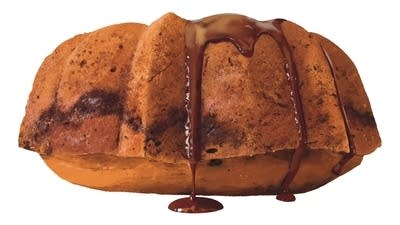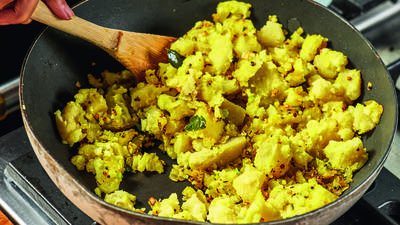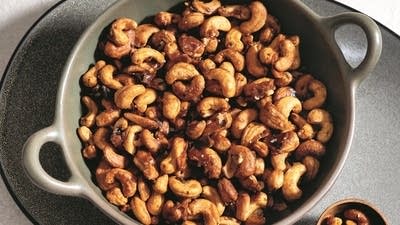
Mary Roach, author of Gulp: Adventures on the Alimentary Canal, shares what she discovered about the science of how we eat: saliva's superpowers, our second set of nostrils, and how we use our ears and nose to taste food.
 Mary Roach (Chris Hardy)
Mary Roach (Chris Hardy)
Lynne Rossetto Kasper: I looked at this whole book, and I have to say, one of the things that really grabbed me was saliva. You make saliva sound like a superhero.
Mary Roach: It’s true, saliva is the most misunderstood substance; it’s the Rodney Dangerfield of bodily products -- I feel that it is. It really is fairly miraculous. People associate it with bacteria, but in fact it has these amazing antibacterial and antiviral properties. It protects your teeth. I don’t even know where to begin.
LRK: Why do we say that our mouths are this breeding place for all this harmful stuff? What’s the good side of saliva in this case?
MR: It’s a bizarre thing because in fact there is bacteria every time you eat something; when you put your finger in your mouth, you are introducing bacteria. Of course it is warm and moist, so it’s this perfect playground for bacteria.
But on the other hand, they have done these studies that have shown that if you don’t let an animal lick its wounds -- this was done with rodents -- the wound will heal more slowly. In other words, if they are allowed to rub this disgusting substance into the wound, it heals more quickly. It contains things like nerve growth factor and skin growth factor. Human saliva has something called histatins, which means wound closure. So someone needs to bottle this stuff.
Of course in humans, one of the main things that saliva does is start to break down some of the things like starch. In fact amylase, which is the enzyme that breaks down starch, is one of the same enzymes that you find in laundry detergent. Essentially laundry detergent is a digestive tract in a box, it’s got three different digestive enzymes.
I asked an expert: Is it then the case that if you dribble something in a restaurant -- where you get something on your clothes -- shouldn’t you just put a dab of saliva on it? Doesn’t that make more sense than soda water? I couldn’t get him to admit that he puts spit on his own clothes. He carries a Tide Stain pen, sadly, but I’m going to continue to do that.
LRK: Why is it when I think of something delicious, my mouth waters?
MR: Now this is one of the weirdest things. I came across not one but two studies that were done, looking into whether in fact the smell of food or the sight of food causes the mouth to water. One of them was done in the 1960s by someone named Alexander Kerr; it was a laboratory study where he had people come into the lab. First of all, they were hungry. They hadn’t eaten, and he started frying eggs in front of them. You had that sight, the smell, the sound. He had outfitted them with a salivary-detection device -- a type II outflow recorder I believe was the device -- and in fact there was not an increase in their outflow. The subjects themselves were like, “No, that’s wrong, I can feel it.” And, he said, “No, no, no, when you are thinking about food, you are suddenly aware of your mouth and you are thinking about the saliva that has been there all along.”
I have seen the study and I still don’t believe it. It's just your body preparing to begin the process of moistening food. The basic thing that saliva does is moisten -- when you chew it up, it forms a bolis, a long cylindrical blob that you can easily swallow. So it’s holding the pieces together. Saliva is helping you swallow; when you see food, you're just giving the heads up that food is coming, sort of getting the machinery working.
LRK: You mentioned smell -- there’s something else that you talked about in the book: two sets of nostrils?
 Gulp: Adventures on the Alimentary Canal
Gulp: Adventures on the Alimentary Canal
MR: Yes, this was news to me. You have a set of internal nostrils. They’re called the posterior nares -- nares meaning nostrils in the back of the mouth. They are the opening between the mouth and the nasal cavity and the soft palate; you have this passageway such that when you are chewing food or you have wine in your mouth, a lot of the flavor components are olfactory. They come up through those nostrils into the top of the nasal cavity, which is where all of the smelling goes on -- the olfactory epithelium. So you have two kinds of smelling that you do with your external nostrils and internal nostrils.
LRK: Are those two different areas experiencing scent in different ways?
MR: Yes. The exterior nostrils, the ones that most people are familiar with, work on the inhale, and the internal nostrils are more on the exhale. If you’ve got wine in your mouth and you exhale, you are wafting wine in your lungs up out of your nose. You are carrying those volatiles, those lovely flavor components, up through the nose and out, so you are getting a second whammy on the olfactory components of whatever it is that is in your mouth. Once I learned that, I have now become this weird person who holds food in her mouth and exhales through the nose -- to me, most of the aroma happens when you do that.
LRK: At this moment, you have changed how at least a part of America is going to be eating in the future. You actually found a crunch expert?
MR: I did, in the Netherlands. He studied the physics of crispy-crunchy for going on 7 years. Oddly, the man told me, “I actually don’t like chips and such,” which I found fascinating.
It’s true that we eat to a certain extent with our ears. That loud, satisfying crunch of a potato chip: It's called a brittle fracture. What’s going on is that you are slowly destroying the structure. The energy is building up, then it breaks and suddenly gives way, and the energy is released very, very quickly and the crack forms so fast it actually travels at the speed of sound. What you are hearing is a tiny sonic boom in your mouth. Who knew?
If you break it down, it’s actually 100 tiny bubbles bursting. It signals to you that this is something fresh, so perhaps evolutionary-speaking this is something that told us, “Aha, this is fresh. It is not rotting. It’s got all its nutritional goodness.” So it’s something we like; we are drawn to it.
LRK: Can you set it up so that I can’t hear what I am eating, but I am still eating that same crunchy potato chip? Is there a different reaction?
MR: There’s a study -- I love food science, I love that someone did this study. But they either muted the sound as someone is eating the chips or they knocked out the higher registers and are playing back a false sound to the person. Then they ask them to rate the freshness of that chip. People will say, “No, this is staler.” It actually overrides the physical sensation in the mouth.
Before you go...
Each week, The Splendid Table brings you stories that expand your world view, inspire you to try something new, and show how food connects us all. We rely on your generous support. For as little as $5 a month, you can have a lasting impact on The Splendid Table. And, when you donate, you’ll join a community of like-minded individuals who love good food, good conversation, and kitchen companionship. Show your love for The Splendid Table with a gift today.
Thank you for your support.
Donate today for as little as $5.00 a month. Your gift only takes a few minutes and has a lasting impact on The Splendid Table and you'll be welcomed into The Splendid Table Co-op.




